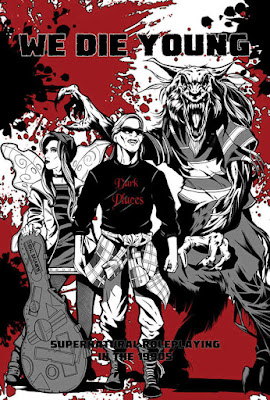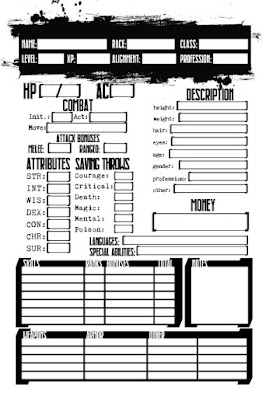"Son, she said, have I got a little story for you
What you thought was your daddy was nothin' but a...
While you were sittin' home alone at age thirteen
Your real daddy was dyin', sorry you didn't see him,
but I'm glad we talked...
Oh I, oh, I'm still alive
Hey, I, I, oh, I'm still alive
Hey I, oh, I'm still alive."
Pearl Jam, "Alive" (1991)
It's October. There's a chill in the air and there is a feeling in the air. Something that makes me reflective, chilly, and maybe a little melancholy. Sounds like the 90s to me. There is also a game that captures this feeling perfectly. Bloat Games' newest offering in the SURVIVE THIS!! series; We Die Young RPG.
I have been waiting to share this with you all and today is that day!
We Die Young RPG Core Rules
"Tell me do you think it would be alright If I could just crash here tonight?"
We Die Young RPG Core Rules is 372 pages with color covers and black and white interior art. The book is digest-sized, so the same size as Bloat Games other games. The game was Eric Bloat & Josh Palmer with art by Phil Stone and additional art by RUNEHAMMER & Diogo Nogueira.
For this review, I am considering the just-released PDF on DriveThruRPG that I got as a Kickstarter backer. The print book is due out soon.
Comparisons between this game and their first game, Dark Places & Demogorgons are natural and I think needed. I spent a lot of time with DP&D so I am looking forward to seeing how I can use this game with that as well. But first, let's get into the game proper.
The book begins with two dedications from the authors. I want to repeat them here since they set the tone not just for the game but also for my review.
Introduction
"With the lights out, it's less dangerous. Here we are now, entertain us."
Here we are introduced to the newest SURVIVE THIS!! game. The authors are upfront about their inspirations here; grunge music from the 90s and the games that were popular at the time. Having already gone through the book a few times it is a thread that weaved in overt and subtle ways, but it never feels overused, hackneyed, or clichéd. We are given some in-game background for why the Pacific Northwest is so full of supernatural strangeness and it is a fun explanation. But to quote the late, great Bard of Seatle I prefer it "always been and always be until the end." But it works well.
The basics of RPGs are covered and what you need to play. Next we get into character creation.
Character Creation
"I'll be whatever you want. The bong in this Reggae song."
Character creation follows the same process as other SURVIVE THIS!! games and by extension most Old-School games. We are told from the word go that we can add material we want from the other SURVIVE THIS!! games.
Attributes are covered which include the standard six, plus the "Survive" attribute common to all SURVIVE THIS!! games. My first thought? My Dark Places and Demogons characters have grown up and moved to Seatle.
Like the other games in this family, Hit Points start with a 2d6 and increase by 1d6 per level regardless of class or race. Combat can be quite deadly in these games for people used to the hardiness of even Old-School D&D characters.
Saving Throws are different from D&D but the same as DP&D with the edition of the Magic save. This does make porting over characters and ideas from the other games pretty easy.
Alignment covers Righteous, Law, Neutral, Anarchist, and Evil.
Races
"All I can say is that my life is pretty plain, You don't like my point of view and I'm insane."
Here we get into the really new material. We have a bunch of new races for this setting. These include shapeshifting Doppelgangers, undead Ghouls, garden variety Humans, the immortal Imperishables, the ancient undead Jari-Ka, the various Realm-Twisted Fey (my new favorite, and I am sure I dated a Twitter Fey back then), Vampires (sparkles are optional), and Were-beasts of all stripes. If you played ANY RPG in the 1990s you know what you are getting here, but still, they manage to make it feel both new and old at the same time. New, because there is new potential here and old because they feel comfortably familiar; like that old flannel in the back of your closet or those beat-up old Doc Martens.
The races are well covered and you could easily drop them into any other SURVIVE THIS!! game or even any other Old-School game. They are really quite fun and I could not help but think of what characters I wanted to make with each one. This covers about 40 pages.
This is followed by a list of occupations with their bonuses.
Classes
"This place is always such a mess. Sometimes I think I'd like to watch it burn."
We Die Young is a class/level system. There 16 classes for this game. Some look like repeats from DP&D but are not really. They are updated to this setting and older characters. We are told that classes from the other SURVIVE THIS!! games are welcome here.Our classes include the Mystic (tattoos mages), Naturalists (potheads, I mean druids), Papal Pursuant (soldiers of God), Psions (Carrie), Revenant (Eric Draven the Crow), Riot Grrl (what it says on the tin), Rock Star, Serial Killer, Shaman (oh here are the potheads), Sickmen (homeless, as seen by Sound Garden), Street Bard, Street Fighters, Thralls (Vampire servants), Tremor Christs (psionically powered religious prophets), Warlock (steal power for otherworlds), and what I can only assume is an attempt to get a good review from me (just kidding!) the Witch.
The witch here is slightly different than the ones we find in DP&D. So there can be no end to the witchy goodness you can have by combining games.
That covers a healthy 50 pages.
Skills
The skill system for We Die Young is the same as DP&D. Though without checking it feels a bit expanded. You get points to put into skills and there are DCs to check. Very 3e. Or more like 3e IF it had been written in 1995. So, yeah, another solid point for this game.
Magic (& Psionics)
"Show me the power child, I'd like to say. That I'm down on my knees today."
Here is one of my favorite things in a game. There is a mythos added to the system here that is rather fun (see Spellcasters & Salt) as well as rules for Rune-Tattoos. Yeah, this is the 90s alright!
Now I have to say this. If adding a witch class is trying to get me to do a good review, then these spell names are outright flirting with me. Spells called "All Apologies", "Heaven Beside You", "Black Days", "Wargasm", "Super Unknown", and "Far Behind"? Yeah. That is hitting me where I live. And that is only the very tip of the iceberg.
Magic, Spells and Psionics cover a little over 60 pages and I feel they could have kept going.
Equipment
"What did you expect to find? Was there something you left behind?"
No old-school flavored game is complete without a list of equipment. This includes common items, weapons, and even magical items. Don't fret, it's not like there is a Magic Shop there. A "Health Locker" costs $50k and that is if you can find one.
The list of drugs is really interesting and fun. Look. It was the 90s. Everybody was taking drugs.
New to this setting are the Zapatral Stones. These are the remains of a meteorite that fell to Earth and hit the Pacific Northwest and Mount Rainer in particular. They have strange power and effects depending on the size of the stone and the color.
Playing the Game
"Whatsoever I've feared has come to life. Whatsoever I've fought off became my life."
Here we get our rules for playing the We Die Young game. We get an overview of game terms, which is nice really. New rules for Curses, Exorcisms, and Madness are covered. It looks like to me they could be backported to DP&D rather easily.
There is a fair number of combat rules. Likely this has come about from the authors' experiences with their other game Vigilante City.
We also get rules for XP & Leveling Up and Critical tables.
The World of We Die Young
"I'm the Man in the Box. Buried in my shit."
This is great stuff. This is the built-in campaign setting for We Die Young set place in a mythical and magical Pacific Northwest. the TL;DR? Grunge woke supernatural creatures. Ok, I can do that. I mean it is not all that different than ShadowRun right?
The setting of the PNW/Seatle on the 90s is covered well. I had many college friends that made the trek out to Seatle after our graduations (91 to 93 mostly), so I have some idea of what was happening on the ground level. Twenty-somethings like me seemed drawn to the place by some mystic siren song. A siren song with a Boss DS-2 distortion pedal.
Various associations/groups are covered, like Jari-Ka circles, Ghoul Legacies, Vampire Lineages, were-kin groups. Like I said, if you played RPGs in the 90s you know the drill. But again they are still both "new" and "old" at the same time. Kudos to the authors for giving me something new AND invoking nostalgia at the same time.
We also get some great locations of note and some adventure seeds which include some creatures.
Bestiary
"She eyes me like a Pisces when I am weak. I've been locked inside your heart-shaped box for weeks."
This covers all the creatures you can run into. The stat blocks are similar enough to Basic-era D&D to be roughly compatible. They are 100% compatible with other SURVIVE THIS!! games, so the excellent DARK PLACES & DEMOGORGONS - The Cryptid Manual will work well with this. In fact, I highly recommend it for this.There is a good variety of creatures. Angels, Demons, BIGFOOT! and more.
We get about 47 pages or so of monsters with stat blocks and an additional 10 pages of templates to add to monsters such as "Vampire" and "Radioactive."
Radioactive Bigfoot. I don't need a plot. I have that!
We get Adventure Hooks next. Roll a d100 and go!
The Appendix includes some Grung songs to get you into the mood. Some Seattle Grunge bands, some not-Seatle Grunge Bands, and some late 80's and 90's Alternative bands.
There is a list of movies about the era. A list of books. And finally the index and OGL.
Thoughts
Wow. What a really damn fun game!
If Dark Places & Demogorgons gave a "Stranger Things" 80s, this gives me a strange supernatural 90s.
It is exactly what I would have expected from the fine folks at Bloat Games.
My ONLY question about this setting is "Where are the UFOs and Aliens?" I mean NOTHING was bigger in the 90s than "The X-Files." I get that it is hard to cleave 90s Aliens to 90s supernatural (ask anyone that has tried to play WitchCraft AND Conspiracy X), but maybe a supplement is due out later? I would suggest grabbing DARK PLACES & DEMOGORGONS - The UFO Investigator's Handbook to add some X-Files flavored goodness to We Die Young.
Back in the early 2000s I had a game I was running, Vacation in Vancouver. It took place in the 90s and in Vancouver (naturally). These rules make me want to revive that game and see where I could take it now.
The bottom line for me is that SURVIVE THIS!! We Die Young RPG is a great game. The pdf is fantastic and I can't wait for my Kickstarter books.





















































